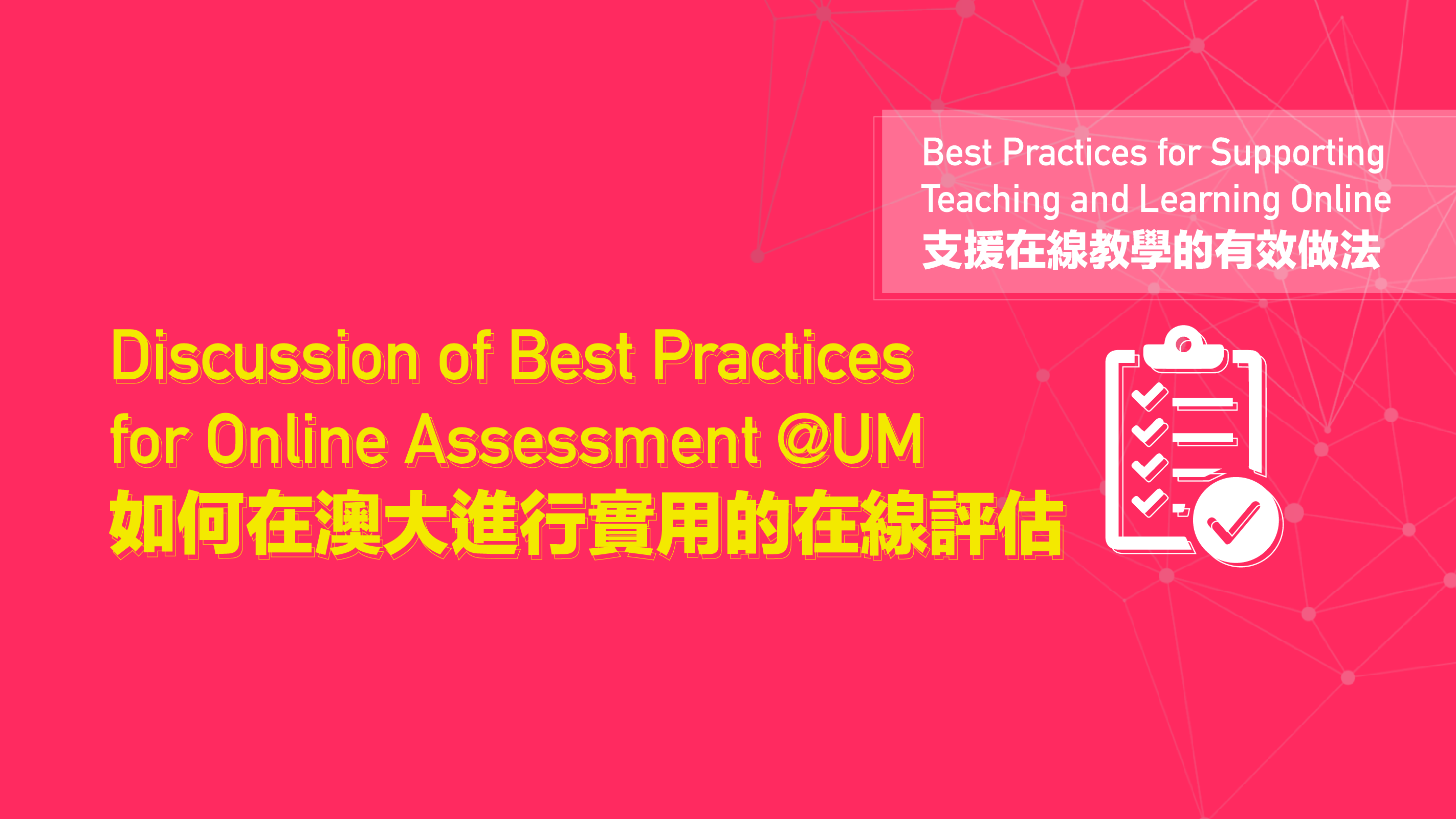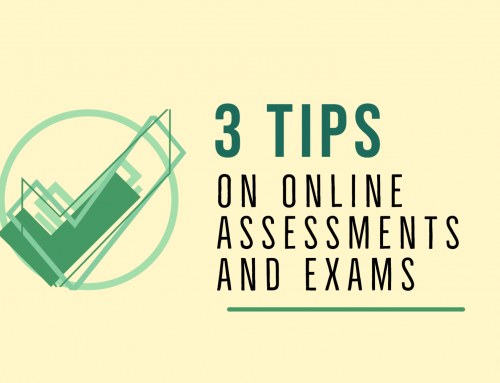Project Description

Best Practices for Supporting Teaching and Learning Online
With online learning now being implemented at the University of Macau, committed teachers are holding classes online with UMMoodle and Zoom. This blog post features some of our colleagues’ tips and best practices. Let’s see what has worked well to support teaching and learning of different disciplines in an online environment.
.
Discussion of Best Practices for Online Assessment @UM
By Katrine Wong, Chuang Wang, Glenn McCartney, John Chan, Miguel Costa, Patrick Chu, Dora Gago, Alice Lee, Alice Lei, Thomas Lok, Ricardo Moutinho, M. P. Ramaswamy, Emily Wang, Bingpu Zhou and Chris Fulton
CTLE Academic Staff Advisors, the Dean of the Faculty of Education, Associate Dean of the Faculty of Business Administration and the Director of CTLE recently met online and discussed ways to support students and conduct online assessment of learning.
Communication, flexibility and adaptability are key during this period.
It is vital to maintain communication with students during this period of online learning. Email, UMMoodle, Zoom or WeChat are platforms that can be used to communicate with students. As teachers, we need to communicate with students to better understand their needs and provide updated information. Indeed, and inevitably, the assessment strategies for our courses will need to be adjusted since mid-term quizzes/exams cannot be scheduled on campus and we feel that students must be fully informed of any changes in this aspect.
Adopting different approaches to assessing undergraduate and graduate students’ learning is advised. For graduate courses with fewer students, we can use open, take-home assignments to assess higher-order thinking skills. We can use Veriguide or Turnitin to help us check academic honesty. For undergraduate courses, it is good to have timed, closed tests to assess individual learning.
Be flexible. Provide students with options to submit assignments through UMMoodle or email. Whenever possible, use assessment tools and resources that your students can access.
- If a tool or app works well for group work, group interaction or sending timely information, such as UMMoodle or WeChat, then use it.
- If a ‘mid-term’ is still chosen during the class schedule (on Zoom for example) and there are technical difficulties or students no-show, one may have to consider doing a ‘make-up’.
We also recommend that more short, low-stakes quizzes, case-studies and small assignments be introduced. This should greatly reduce the stress that students feel on a timed, high-stakes mid-term quiz/exam, on which the students could face technical or network issues. Also, it is a good idea to reduce the weight of mid-terms. What is most important is that assessments show that students meet the intended learning outcomes of courses.
A note of caution: if a course is connected to an international accreditation process, we need to ensure the assessment keeps in line with the requirements.
Two well-known tools at UM that are used to check for academic honesty are Veriguide and Turnitin, which can help with reviewing text-based assignments. For online assessments, we will continue to explore new tools such as the attention tracking function in Zoom, Safe Exam Browser or full-screen mode with UMMoodle quizzes and find out what works well with our students and colleagues.
支援在線教學的有效做法
澳大目前正積極推行在線遙距學習,不同學院的教師們通過UMMoodle和Zoom的方式進行在線課程。這篇教學網誌將介紹他們的有用貼士和例子。齊來了解不同學科的遙距教與學實用方法!
如何在澳大進行實用的在線評估
共同撰文:
王嘉祺主任(CTLE)、王闖院長(FED)、Glenn McCartney副院長(FBA)、朱國權教授(FBA)、Ricardo Moutinho 教授(FAH)、Dora Gago 教授(FAH)、李思敏教授(FED)、M. P. Ramaswamy教授(FLL)、陸萬海教授(FST)、王穎教授(ICMS)、周冰朴教授(IAMPE)、Alice Lee 博士(FAH-ELC)、Chris Fulton 博士(CTLE)、Miguel Costa先生(FST)、陳顓先生(ICTO)
日前教與學優化中心主任、教育學院院長、工商管理學院副院長及本中心的學術顧問團隊舉行了一次網上會議,討論在線學習中有關支援學生,以及學習評估的方法。全體一致認為溝通、靈活、和適應在停課期間都很重要。
與學生保持溝通:教師可通過電郵、UMMoodle、Zoom,或微信等平台與學生交流。作為老師,我們需要通過溝通更好地了解學生的需要,並及時提供最新資訊。與此同時,由於期中測驗和考試不能夠安排在校園進行,課程的評估方式需因應作出調整,我們需要確保學生們知道這些變動及調整。
採用不同的學習評估方法:對於較少人數的研究生課程,老師可以使用開卷作業,來評估學生的高階思維技能( higher-order thinking skills );也可以使用Veriguide或Turnitin來檢驗學術誠信要求。本科生課程方面,最好設計限時、封閉式的測驗來評估學生的學習成效。
保持靈活變通:建議給學生提供不同選擇,例如:學生可選擇通過UMMoodle或電郵方式提交作業,盡可能使用學生可以容易存取的評估工具和教學資源:
- 考慮使用能促進小組合作、互動、即時通訊的工具或程式,如UMMoodle或微信。
- 如果老師使用Zoom進行評估,但遇到技術疑難或學生缺席等情況,復課後可能需要進行補課。
我們還建議老師引入更多簡短,佔分較少的測驗、案例研究和小作業來代替限時、佔分較重的中期測驗和考試,大大減低學生所承受的壓力,並減少網絡連接等問題。另外,適度調低中期的佔分比率也不錯,更最重要作業能有效評估學生是否達到課程的預期學習成果。要注意的是,如果相關課程獲國際認證,老師要確保課程評估需達到相關要求。
澳大老師可使用Veriguide和Turnitin 兩個工具檢查學術誠信,檢測以文字為基礎的作業。我們將繼續探索評估線上作業的輔助工具,例如Zoom中的專注力追蹤功能( attention tracking ),用於UMMoodle測驗的安全考試瀏覽器 (Safe Exam Browser)和全屏幕模式(Full-Screen Mode)等,並找出最適合澳大老師及學生使用的方法。





